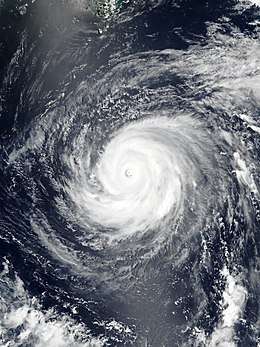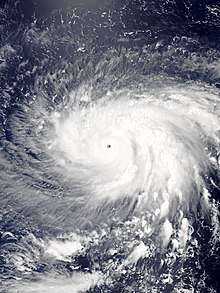Typhoon Maria (2018)
| Typhoon (JMA scale) | |
|---|---|
| Category 5 super typhoon (SSHWS) | |
 Typhoon Maria at peak intensity on July 9 | |
| Formed | July 3, 2018 |
| Dissipated | July 12, 2018 |
| Highest winds |
10-minute sustained: 195 km/h (120 mph) 1-minute sustained: 260 km/h (160 mph) |
| Lowest pressure | 915 hPa (mbar); 27.02 inHg |
| Fatalities | 2 total |
| Damage | $490 million (2018 USD) |
| Areas affected | Mariana Islands, Ryukyu Islands, Taiwan, China |
| Part of the 2018 Pacific typhoon season | |
Typhoon Maria, known in the Philippines as Typhoon Gardo, was a powerful tropical cyclone that affected Guam and Taiwan. Developing into the eighth named tropical storm of the northwest Pacific Ocean and impacting the Mariana Islands on July 4, Maria strengthened into the fourth typhoon of this season and underwent extremely rapid intensification the next day, due to favorable environmental conditions. The typhoon reached its first peak intensity on July 6; subsequently, Maria weakened due to an eyewall replacement cycle, but it re-intensified and reached its second peak intensity on July 8. Later, it started to gradually weaken due to colder sea surface temperatures. After hitting the Yaeyama Islands and affecting Taiwan on July 10, Maria ultimately made landfall over Fujian, China, early on July 11, before dissipating on the next day.
Meteorological history

A tropical disturbance formed over the Marshall Islands late on June 26.[1] After the slow development and westward drift for five days, the Joint Typhoon Warning Center (JTWC) issued a Tropical Cyclone Formation Alert early on July 2 and upgraded the system to a tropical depression with the designation 10W late on the same day.[2][3] Early on July 3, the Japan Meteorological Agency upgraded the low-pressure area into a tropical depression southeast of Guam and subsequently started to issue tropical cyclone warnings.[4][5] Favorable environmental conditions, including moderate vertical wind shear, poleward outflow enhanced by tropical upper tropospheric trough (TUTT) cells located to the northeast and to the northwest, sea surface temperatures between 30 and 31 °C, were contributing to the development of the system on July 4. As the result, JMA upgraded it to a tropical storm and assigned the international name Maria at around 12:00 UTC,[6] and JTWC also upgraded it to a tropical storm.[7] Six hours later, when the storm struck Guam directly, surface observations at Andersen Air Force Base recorded one-minute maximum sustained winds at 50 knots (93 km/h; 58 mph) and a minimum pressure at 984 hPa (29.06 inHg), indicating a rapidly consolidating system.[8]

On July 5, Maria drifted northwestward slowly under the influences of a weak north-south oriented steering ridge and a strong east-west oriented subtropical ridge entrenched to the north. After being upgraded to a severe tropical storm by JMA and a typhoon by JTWC early on the same day,[9] Maria started extremely rapid intensification due to highly favorable conditions.[10] Microwave imagery revealed an eye and the JMA upgraded Maria to a typhoon in the afternoon.[11] The JTWC upgraded Maria to a super typhoon and reported that it reached its initial peak intensity with one-minute maximum sustained winds of 260 km/h (160 mph) at around 00:00 UTC on July 6,[12] making it the first Category 5-equivalent tropical cyclone in the northern hemisphere since a homonymous Atlantic hurricane in September 2017.[nb 1]
At around 01:10 UTC on July 11, Maria made landfall over the Huangqi Peninsula of Lianjiang County, Fuzhou in Fujian, China, with ten-minute maximum sustained winds at 155 km/h (100 mph) and a central pressure of 955 hPa (28.20 inHg).[13] Afterward, Maria rapidly weakened overland, before dissipating on July 12.
Impact
Guam
Maria damaged a number of KC-135 aircraft in Andersen Air Force Base when sweeping through Guam as a tropical storm on July 4.[14]
East China
Total economic losses in East China were estimated to be CN¥3.28 billion (US$490 million).[15]The storm caused severe flooding in Fujian. About 135,000 to 200,000 people were reported to have lost power.
See also
Notes
- ↑ According to the best track data of 2017, there was no category 5-equivalent system in the north Indian Ocean and even the north Pacific Ocean.
References
- ↑ "Index of /tcdat/tc18/WPAC/10W.MARIA/ir/geo/1km". United States Naval Research Laboratory. Retrieved July 9, 2018.
- ↑ "Tropical Cyclone Formation Alert". WIS Portal – GISC Tokyo. Joint Typhoon Warning Center. July 2, 2018. Archived from the original on July 9, 2018. Retrieved July 9, 2018.
- ↑ "Prognostic Reasoning for Tropical Depression 10W (Ten) Warning Nr 01". Joint Typhoon Warning Center. July 2, 2018. Archived from the original on July 2, 2018. Retrieved July 9, 2018.
- ↑ "WWJP25 RJTD 030000". Japan Meteorological Agency. July 3, 2018. Archived from the original on July 3, 2018. Retrieved July 9, 2018.
- ↑ "RSMC Tropical Cyclone Advisory WTPQ21 RJTD 030600". Japan Meteorological Agency. July 3, 2018. Archived from the original on July 3, 2018. Retrieved July 9, 2018.
- ↑ "RSMC Tropical Cyclone Advisory WTPQ21 RJTD 041200". Japan Meteorological Agency. July 4, 2018. Archived from the original on July 4, 2018. Retrieved July 9, 2018.
- ↑ "Prognostic Reasoning for Tropical Storm 10W (Maria) Warning Nr 08". Joint Typhoon Warning Center. July 4, 2018. Archived from the original on July 4, 2018. Retrieved July 9, 2018.
- ↑ "Prognostic Reasoning for Tropical Storm 10W (Maria) Warning Nr 09". Joint Typhoon Warning Center. July 4, 2018. Archived from the original on July 4, 2018. Retrieved July 10, 2018.
- ↑ "RSMC Tropical Cyclone Advisory WTPQ21 RJTD 050300". Japan Meteorological Agency. July 5, 2018. Archived from the original on July 5, 2018. Retrieved July 10, 2018.
- ↑ "Prognostic Reasoning for Typhoon 10W (Maria) Warning Nr 11". Joint Typhoon Warning Center. July 5, 2018. Archived from the original on July 5, 2018. Retrieved July 10, 2018.
- ↑ "RSMC Tropical Cyclone Advisory WTPQ21 RJTD 051500". Japan Meteorological Agency. July 5, 2018. Archived from the original on July 5, 2018. Retrieved July 10, 2018.
- ↑ "Prognostic Reasoning for Super Typhoon 10W (Maria) Warning Nr 14". Joint Typhoon Warning Center. July 6, 2018. Archived from the original on July 6, 2018. Retrieved July 10, 2018.
- ↑ ""玛莉亚"在福建连江黄岐半岛登陆" (in Chinese). National Meteorological Center of CMA. July 11, 2018. Archived from the original on July 11, 2018. Retrieved July 11, 2018.
- ↑ Insinna, Valerie (July 6, 2018). "Typhoon in Guam damages several KC-135s". Defense News. Retrieved July 9, 2018.
- ↑ "强台风"玛莉亚"造成1.3万间房屋倒损". 中华人民共和国减灾委员会. July 13, 2018.
External links
| Wikimedia Commons has media related to Typhoon Maria (2018). |
- JMA General Information of Typhoon Maria (1808) from Digital Typhoon
- 10W.MARIA from the U.S. Naval Research Laboratory
